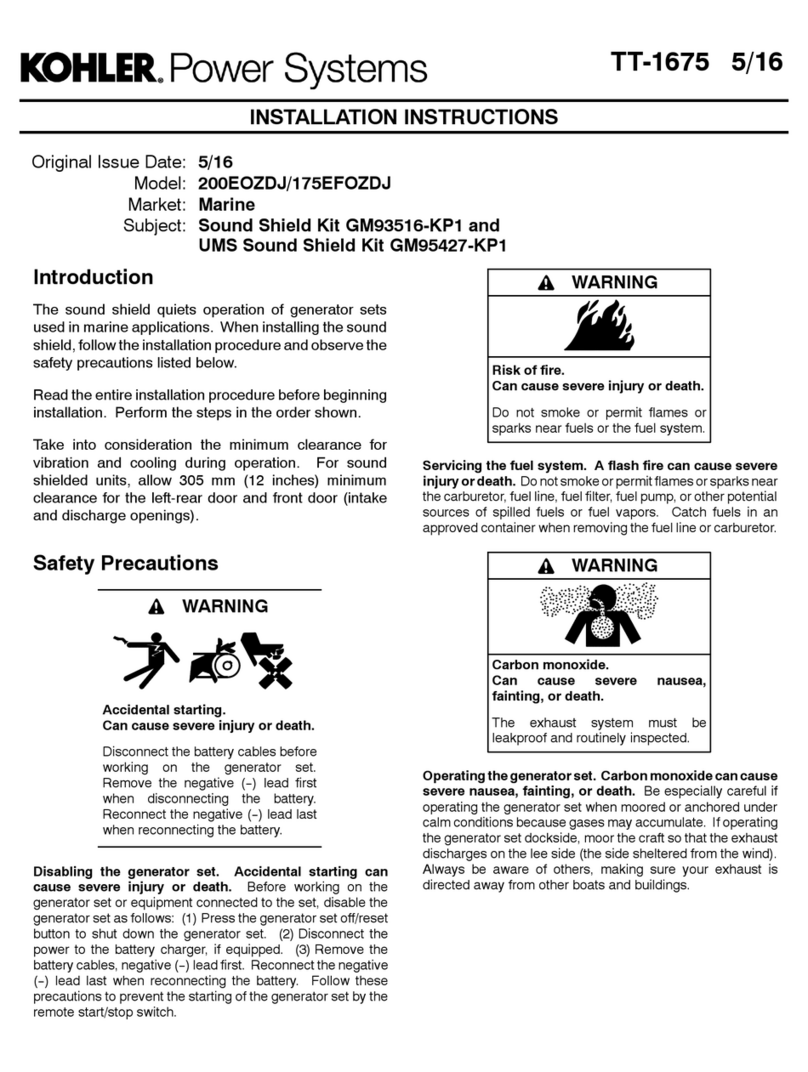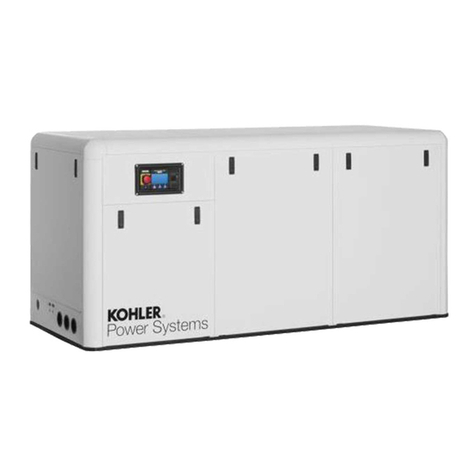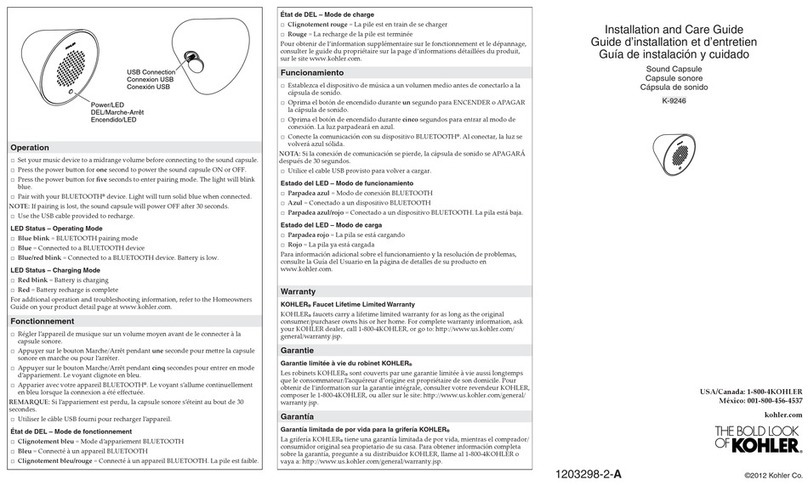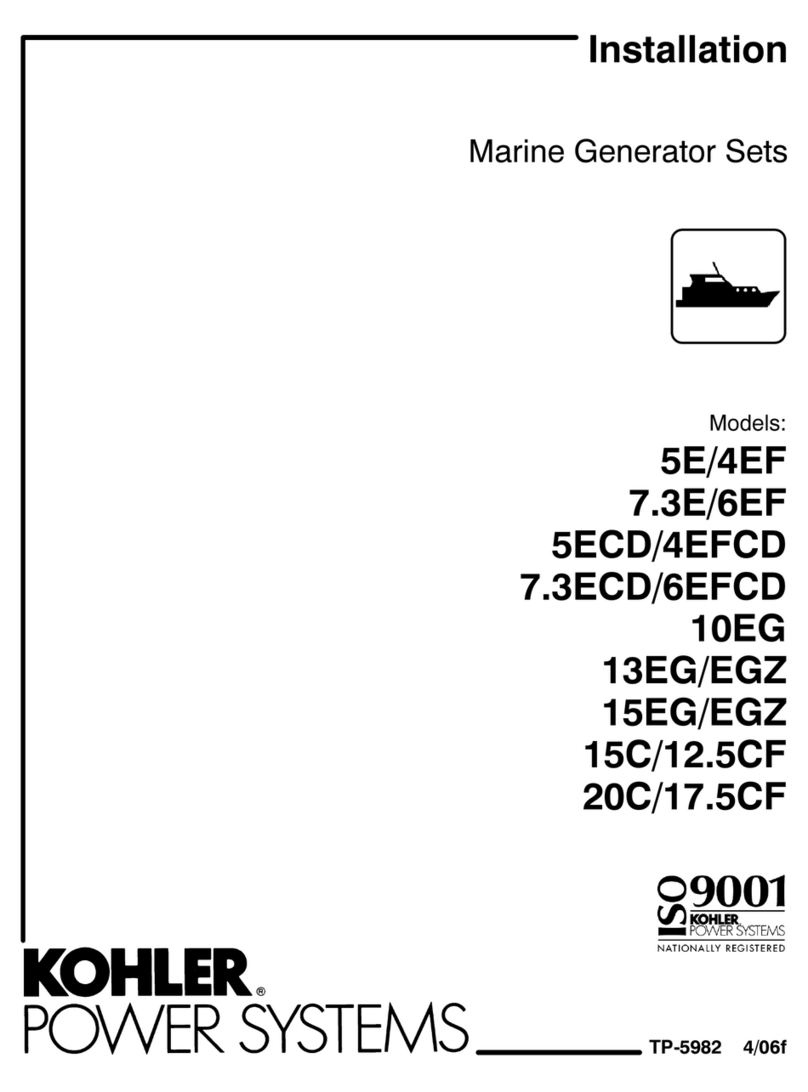Kohler 6EOD Instruction Manual

Marine Generator Sets
Models:
6EOD
4.5EFOD
8--32EOZD
6.5--27EFOZD
TP-6252 2/08c
Operation

TP-6252 2/082
Engine exhaust from this product contains chemicals
known to the State of California to cause cancer, birth
defects, or other reproductive harm.
WARNING
California Proposition 65
Product Identification Information
Product identification numbers determine service parts.
Record the product identification numbers in the spaces
below immediately after unpacking the products so that
the numbers are readily available for future reference.
Record field-installed kit numbers after installing the
kits.
Generator Set Identification Numbers
Record the product identification numbers from the
generator set nameplate(s).
Model Designation
Specification Number
Serial Number
Accessory Number Accessory Description
Engine Identification
Record the product identification information from the
engine nameplate.
Manufacturer
Model Designation
Serial Number
x:in:007:001

TP-6252 2/08 Table of Contents 3
Table of Contents
ProductIdentificationInformation 2............................................................
SafetyPrecautionsandInstructions 5........................................................
Introduction 9...............................................................................
ServiceAssistance 10........................................................................
Maintenance and Service Parts/Related Literature 11. . . . . . . . . . . . . . . . . . . . . . . . . . . . . . . . . . . . . . . . . . . .
Section1 ServiceViews 13...................................................................
Section2 Operation 15.......................................................................
2.1 PrestartChecklist 15.....................................................
2.2 MarineInspection 16.....................................................
2.3 AngularOperation 16.....................................................
2.4 Operation in European Union Member Countries 16. . . . . . . . . . . . . . . . . . . . . . . . . .
2.5 LoadProfile 16..........................................................
2.6 Advanced Digital Control Operation 17. . . . . . . . . . . . . . . . . . . . . . . . . . . . . . . . . . . . . .
2.6.1 ControlsandIndicators 17........................................
2.6.2 Starting the Generator Set 18. . . . . . . . . . . . . . . . . . . . . . . . . . . . . . . . . . . . . .
2.6.3 Stopping the Generator Set 19. . . . . . . . . . . . . . . . . . . . . . . . . . . . . . . . . . . . .
2.6.4 FaultShutdowns 19..............................................
2.6.5 Resetting the Controller after a Fault Shutdown 21. . . . . . . . . . . . . . . . . . . .
2.6.6 Continuous Power Mode if Equipped with a Remote Gauge 21. . . . . . . . .
2.7 CircuitProtection 22......................................................
2.7.1 LineCircuitBreaker 22...........................................
2.7.2 Fuses 22.......................................................
Section3 ScheduledMaintenance 23..........................................................
3.1 GeneralMaintenance 23..................................................
3.2 Service Schedule—6EOD and 4.5EFOD Models 24. . . . . . . . . . . . . . . . . . . . . . . . . .
3.3 Service Schedule—8EOZD and 6.5EFOZD Models 26. . . . . . . . . . . . . . . . . . . . . . . .
3.4 Service Schedule—9--32EOZD and 7--27EFOZD Models 28. . . . . . . . . . . . . . . . . . .
3.5 LubricationSystem 30....................................................
3.5.1 OilSpecifications 30..............................................
3.5.2 OilCheck 30....................................................
3.5.3 OilChange 31...................................................
3.6 FuelSystem 32..........................................................
3.6.1 FuelSpecifications 32............................................
3.6.2 FuelFilter 32....................................................
3.6.3 Bleeding the Fuel System 33. . . . . . . . . . . . . . . . . . . . . . . . . . . . . . . . . . . . . .
3.7 AirIntakeSilencer/Cleaner 34.............................................
3.8 ExhaustSystem 35......................................................
3.9 CoolingSystem 36.......................................................
3.9.1 ClosedHeatExchanger 36........................................
3.9.2 Checking and Filling Coolant 36. . . . . . . . . . . . . . . . . . . . . . . . . . . . . . . . . . . .
3.9.3 FlushingandCleaning 36.........................................
3.9.4 PressureCap 37.................................................
3.9.5 SeawaterPump 37...............................................
3.9.6 SiphonBreak 38.................................................
3.9.7 Anticorrosion Zinc Anode 40. . . . . . . . . . . . . . . . . . . . . . . . . . . . . . . . . . . . . . .
3.10 BeltTension 41..........................................................
3.10.1 Seawater Pump Belt Tensioning Procedure, If Equipped 41. . . . . . . . . . . .
3.10.2 Battery Charging Alternator Belt Tensioning Procedure 41. . . . . . . . . . . . .
3.11 Battery 42...............................................................
3.12 GeneratorStorageProcedure 42...........................................

TP-6252 2/08Table of Contents4
Section4 Troubleshooting 43.................................................................
4.1 FaultCodes 43..........................................................
4.2 ControllerTroubleshooting 43.............................................
Section5 WiringDiagrams 47................................................................
5.1 WiringDiagramReference 47.............................................
AppendixA Abbreviations 55..................................................................
AppendixB OperatingHourServiceLog 57.....................................................

TP-6252 2/08 Safety Precautions and Instructions 5
Safety Precautions and Instructions
IMPORTANT SAFETY INSTRUCTIONS.
Electromechanical equipment,
including generator sets, transfer
switches, switchgear, and accessories,
can cause bodily harm and pose
life-threatening danger when
improperly installed, operated, or
maintained. To prevent accidents be
aware of potential dangers and act
safely. Read and follow all safety
precautions and instructions. SAVE
THESE INSTRUCTIONS.
This manual has several types of safety
precautions and instructions: Danger,
Warning, Caution, and Notice.
DANGER
Danger indicates the presence of a
hazard that will cause severe
personal injury, death, or substantial
property damage.
WARNING
Warning indicates the presence of a
hazard that can cause severe
personal injury, death, or substantial
property damage.
CAUTION
Caution indicates the presence of a
hazard that will or can cause minor
personal injury or property damage.
NOTICE
Notice communicates installation,
operation, or maintenance information
that is safety related but not hazard
related.
Safety decals affixed to the equipment
in prominent places alert the operator
or service technician to potential
hazards and explain how to act safely.
The decals are shown throughout this
publication to improve operator
recognition. Replace missing or
damaged decals.
Accidental Starting
Accidental starting.
Can cause severe injury or death.
Disconnect the battery cables before
working on the generator set.
Remove the negative (--) lead first
when disconnecting the battery.
Reconnect the negative (--) lead last
when reconnecting the battery.
WARNING
Disabling the generator set.
Accidental starting can cause
severe injury or death. Before
working on the generator set or
connected equipment, disable the
generator set as follows: (1) Move the
generator set master switch to the OFF
position. (2) Disconnect the power to
the battery charger. (3) Remove the
battery cables, negative (--) lead first.
Reconnect the negative (--) lead last
when reconnecting the battery. Follow
these precautions to prevent starting of
the generator set by an automatic
transfer switch, remote start/stop
switch, or engine start command from a
remote computer.
Engine Backfire/Flash
Fire
Fire.
Can cause severe injury or death.
Do not smoke or permit flames or
sparks near fuels or the fuel system.
WARNING
Servicing the fuel system. A flash
fire can cause severe injury or death.
Do not smoke or permit flames or
sparks near the fuel injection system,
fuel line, fuel filter, fuel pump, or other
potential sources of spilled fuels or fuel
vapors. Catch fuels in an approved
container when removing the fuel line
or fuel system.
Servicing the air cleaner. A sudden
backfire can cause severe injury or
death. Do not operate the generator
set with the air cleaner/silencer
removed.
Combustible materials. A sudden
flash fire can cause severe injury or
death. Do not smoke or permit flames
or sparks near the generator set. Keep
the compartment and the generator set
clean and free of debris to minimize the
risk of fire. Catch fuels in an approved
container. Wipe up spilled fuels and
engine oil.
Combustible materials. A fire can
cause severe injury or death.
Generator set engine fuels and fuel
vapors are flammable and explosive.
Handle these materials carefully to
minimize the risk of fire or explosion.
Equip the compartment or nearby area
with a fully charged fire extinguisher.
Select a fire extinguisher rated ABC or
BC for electrical fires or as
recommended by the local fire code or
an authorized agency. Train all
personnel on fire extinguisher
operation and fire prevention
procedures.

TP-6252 2/086 Safety Precautions and Instructions
Exhaust System
Carbon monoxide.
Can cause severe nausea,
fainting, or death.
The exhaust system must be
leakproof and routinely inspected.
WARNING
Carbon monoxide symptoms.
Carbon monoxide can cause severe
nausea, fainting, or death. Carbon
monoxide is a poisonous gas present in
exhaust gases. Carbon monoxide is an
odorless, colorless, tasteless,
nonirritating gas that can cause death if
inhaled for even a short time. Carbon
monoxide poisoning symptoms include
but are not limited to the following:
DLight-headedness, dizziness
DPhysical fatigue, weakness in
joints and muscles
DSleepiness, mental fatigue,
inability to concentrate
or speak clearly, blurred vision
DStomachache, vomiting, nausea
If experiencing any of these symptoms
and carbon monoxide poisoning is
possible, seek fresh air immediately
and remain active. Do not sit, lie down,
or fall asleep. Alert others to the
possibility of carbon monoxide
poisoning. Seek medical attention if
the condition of affected persons does
not improve within minutes of breathing
fresh air.
Inspecting the exhaust system.
Carbon monoxide can cause severe
nausea, fainting, or death. For the
safety of the craft’s occupants, install a
carbon monoxide detector. Never
operate the generator set without a
functioning carbon monoxide detector.
Inspect the detector before each
generator set use.
Operating the generator set. Carbon
monoxide can cause severe nausea,
fainting, or death. Be especially
careful if operating the generator set
when moored or anchored under calm
conditions because gases may
accumulate. If operating the generator
set dockside, moor the craft so that the
exhaust discharges on the lee side (the
side sheltered from the wind). Always
be aware of others, making sure your
exhaust is directed away from other
boats and buildings.
Fuel System
Explosive fuel vapors.
Can cause severe injury or death.
Use extreme care when handling,
storing, and using fuels.
WARNING
The fuel system. Explosive fuel
vapors can cause severe injury or
death. Vaporized fuels are highly
explosive. Use extreme care when
handling and storing fuels. Store fuels
in a well-ventilated area away from
spark-producing equipment and out of
the reach of children. Never add fuel to
the tank while the engine is running
because spilled fuel may ignite on
contact with hot parts or from sparks.
Do not smoke or permit flames or
sparks to occur near sources of spilled
fuel or fuel vapors. Keep the fuel lines
and connections tight and in good
condition. Do not replace flexible fuel
lines with rigid lines. Use flexible
sections to avoid fuel line breakage
caused by vibration. Do not operate the
generator set in the presence of fuel
leaks, fuel accumulation, or sparks.
Repair fuel systems before resuming
generator set operation.
Draining the fuel system. Explosive
fuel vapors can cause severe injury
or death. Spilled fuel can cause an
explosion. Use a container to catch fuel
when draining the fuel system. Wipe up
spilled fuel after draining the system.
Hazardous Noise
Hazardous noise.
Can cause hearing loss.
Never operate the generator set
without a muffler or with a faulty
exhaust system.
CAUTION
Hazardous Voltage/
Moving Parts
Hazardous voltage.
Can cause severe injury or death.
Operate the generator set only when
all guards and electrical enclosures
are in place.
Moving parts.
WARNING
Servicing the generator set when it
is operating. Exposed moving parts
can cause severe injury or death.
Keep hands, feet, hair, clothing, and
test leads away from the belts and
pulleys when the generator set is
running. Replace guards, screens, and
covers before operating the generator
set.
Grounding electrical equipment.
Hazardous voltage can cause
severe injury or death. Electrocution
is possible whenever electricity is
present. Ensure you comply with all
applicable codes and standards.
Electrically ground the generator set,
transfer switch, and related equipment
and electrical circuits. Turn off the main
circuit breakers of all power sources
before servicing the equipment. Never
contact electrical leads or appliances
when standing in water or on wet
ground because these conditions
increase the risk of electrocution.

TP-6252 2/08 Safety Precautions and Instructions 7
Disconnecting the electrical load.
Hazardous voltage can cause
severe injury or death. Disconnect
the generator set from the load by
turning off the line circuit breaker or by
disconnecting the generator set output
leads from the transfer switch and
heavily taping the ends of the leads.
High voltage transferred to the load
during testing may cause personal
injury and equipment damage. Do not
use the safeguard circuit breaker in
place of the line circuit breaker. The
safeguard circuit breaker does not
disconnect the generator set from the
load.
Short circuits. Hazardous
voltage/current can cause severe
injury or death. Short circuits can
cause bodily injury and/or equipment
damage.Do not contact electrical
connections with tools or jewelry while
making adjustments or repairs.
Remove all jewelry before servicing the
equipment.
Electrical backfeed to the utility.
Hazardous backfeed voltage can
cause severe injury or death.
Connect the generator set to the
building/marina electrical system only
through an approved device and after
the building/marina main switch is
turned off. Backfeed connections can
cause severe injury or death to utility
personnel working on power lines
and/or personnel near the work area.
Some states and localities prohibit
unauthorized connection to the utility
electrical system. Install a
ship-to-shore transfer switch to prevent
interconnection of the generator set
power and shore power.
Testing live electrical circuits.
Hazardous voltage or current can
cause severe injury or death. Have
trained and qualified personnel take
diagnostic measurements of live
circuits. Use adequately rated test
equipment with electrically insulated
probes and follow the instructions of the
test equipment manufacturer when
performing voltage tests. Observe the
following precautions when performing
voltage tests: (1) Remove all jewelry.
(2) Stand on a dry, approved electrically
insulated mat. (3) Do not touch the
enclosure or components inside the
enclosure. (4) Be prepared for the
system to operate automatically.
(600 volts and under)
Hot Parts
Hot coolant and steam.
Can cause severe injury or death.
Before removing the pressure cap,
stop the generator set and allow it to
cool. Then loosen the pressure cap
to relieve pressure.
WARNING
Notice
NOTICE
Fuse replacement. Replace fuses
with fuses of the same ampere rating
and type (for example: 3AB or 314,
ceramic). Do not substitute clear
glass-type fuses for ceramic fuses.
Refer to the wiring diagram when the
ampere rating is unknown or
questionable.
NOTICE
Saltwater damage. Saltwater quickly
deteriorates metals. Wipe up saltwater
on and around the generator set and
remove salt deposits from metal
surfaces.

TP-6252 2/088 Safety Precautions and Instructions
Notes

TP-6252 2/08 Introduction 9
Introduction
This manual provides operation instructions for 6EOD,
4.5EFOD, 8--32EOZD, and 6.5--27EFOZD model
generator sets.
Refer to the engine operation manual for generator set
engine scheduled maintenance information.
Information in this publication represents data available
at the time of print. Kohler Co. reserves the right to
change this publication and the products represented
without notice and without any obligation or liability
whatsoever.
Read this manual and carefully follow all procedures
and safety precautions to ensure proper equipment
operation and to avoid bodily injury. Read and follow the
Safety Precautions and Instructions section at the
beginning of this manual. Keep this manual with the
equipment for future reference.
The generator set specification sheets provide specific
generator and engine information. Refer to the spec
sheet for data not supplied in this manual. Consult the
generator set service manual, engine operation manual,
and engine service manual for additional specifications.
Obtain copies of the latest spec sheets, manuals,
diagrams, and drawings from your local
distributor/dealer.
The equipment service requirements are very important
to safe and efficient operation. Inspect the parts often
and perform required service at the prescribed intervals.
Obtain service from an authorized service
distributor/dealer to keep equipment in top condition.
Before installing a marine generator set, obtain the
most current installation manual from your local
distributor/dealer. Only qualified persons should
install the generator set.

TP-6252 2/0810 Introduction
Service Assistance
For professional advice on generator set power
requirements and conscientious service, please contact
your nearest Kohler distributor or dealer.
DConsult the Yellow Pages under the heading
Generators—Electric.
DVisit the Kohler Power Systems website at
KohlerPower.com.
DLook at the labels and stickers on your Kohler product
or review the appropriate literature or documents
included with the product.
DCall toll free in the US and Canada 1-800-544-2444.
DOutside the US and Canada, call the nearest regional
office.
Headquarters Europe, Middle East,Africa
(EMEA)
Kohler Power Systems
3 rue de Brennus
93200 Saint Denis
France
Phone: (33) 1 49 178300
Fax: (33) 1 49 178301
Asia Pacific
Power Systems Asia Pacific Regional Office
Singapore, Republic of Singapore
Phone: (65) 6264-6422
Fax: (65) 6264-6455
China
North China Regional Office, Beijing
Phone: (86) 10 6518 7950
(86) 10 6518 7951
(86) 10 6518 7952
Fax: (86) 10 6518 7955
East China Regional Office, Shanghai
Phone: (86) 21 6288 0500
Fax: (86) 21 6288 0550
India, Bangladesh, Sri Lanka
India Regional Office
Bangalore, India
Phone: (91) 80 3366208
(91) 80 3366231
Fax: (91) 80 3315972
Japan, Korea
North Asia Regional Office
Tokyo, Japan
Phone: (813) 3440-4515
Fax: (813) 3440-2727
Latin America
Latin America Regional Office
Lakeland, Florida, USA
Phone: (863) 619-7568
Fax: (863) 701-7131

TP-6252 2/08 Introduction 11
Maintenance and Service Parts/Related Literature
Maintenance and Service Parts
Figure 1 identifies maintenance and service parts for your generator set. Obtain a complete list of maintenance and
service parts from your authorized generator distributor/dealer.
Models
Part
Description
6EOD
and
4.5EFOD
8EOZD
and
6.5EFOZD
9EOZD
and
7EFOZD
10EOZD
and
9EFOZD
13EOZD/
20EOZD
and
11EFOZD/
17EFOZD/
17.5EFOZD
14EOZD/
15.5EOZD/
23EOZD/
24EOZD
and
11.5EFOZD/
13EFOZD/
20EFOZD
28EOZD/
32EOZD
and
23EFOZD/
27EFOZD
Air Filter Element 278858 278858 278858 278858 GM24456 250902 GM16944
Fuse, Auxiliary Winding
(F1) 10 amp 358337 358337 358337 358337 358337 358337 358337
Fuse, Relay
Interface Board
(F2) 10 amp
223316 223316 223316 223316 223316 223316 223316
Fuse, Controller
(F3) 10 amp 223316 223316 223316 223316 223316 223316 223316
Fuel Filter Element GM49315 229715 229715 GM32359 GM32359 GM32359 GM32359
Oil Filter GM40999 229678 229678 252834 252834 252834 252834
Seawater Pump
Impeller Kit GM49316 229826 229826 229826 229955 229955 229826
V-Belt (Alternator)
GM40998 363064 GM47044
225428
(12 volt)
226929
(24 volt)
276148
(12 volt)
276141
(24 volt)
276148
(12 volt)
276141
(24 volt)
363205
(12 volt)
258955
(24 volt)
V-Belt (Seawater Pump) N/A GM13660 GM13660 229125 256503 256503 249989
Zinc Anode N/A 267928 267928 267928 N/A N/A 267928
Figure 1 Maintenance and Service Parts
x:in:001:004

TP-6252 2/0812 Introduction
List of Related Literature
Figure 2 identifies related literature available for the generator sets covered in this manual. Only trained and qualified
personnel should install or service the generator set.
Models
Literature
Type
6EOD
and
4.5EFOD
8EOZD
and
6.5EFOZD
9EOZD
and
7EFOZD
10EOZD
and
9EFOZD
13--15.5EOZD
and
11--13EFOZD
20--24EOZD
and
17--20EFOZD
28/32EOZD
and
23/27EFOZD
Installation
Manual TP-6253
Operation
Manual TP-6252
Parts Catalog* TP-6268 TP-6269 TP-6270 TP-6270 TP-6271 TP-6272 TP-6273
Service Manual
(Engine) TP-6436 TP-5876 TP-6382 TP-6293 TP-6293 TP-6293 TP-6293
Service Manual
(Generator) TP-6255
* Includes generator and engine information.
Figure 2 Generator Set Literature
x:in:001:005

TP-6252 2/08 13Section 1 Service Views
Section 1 Service Views
1. ADC 2100 Control
2. Run-Off/Reset-Auto switch
3. Nameplate
4. Mixing elbow (water outlet/exhaust outlet), far side
5. Air intake silencer/cleaner
6. Lifting eye
7. Coolant overflow bottle (location varies by model)
8. Fuel feed pump
9. Oil check/dipstick
10. Coolant pressure cap
11. Coolant overflow tube
12. Oil fill (engine top)
13. Lube oil filter
14. Fuel filter
15. Oil fill (front gear cover)
16. Seawater pump and water inlet
17. Oil drain valve and hose
18. Strain relief for the load lead cable
19. Alternator cooling air inlet
20. AC circuit breaker panel
21. Anticorrosion zinc anode (seawater drain) (all models except
13--24EOZD & 11--20EFOZD models)
22. Belt guard
23. V-belts
24. Engine coolant drain (all models except 13--24EOZD &
11--20EFOZD models)
25. Heat exchanger (all models except 13--24EOZD &
11--20EFOZD models)
26. Heat exchanger (13--24EOZD & 11--20EFOZD models, internal
to exhaust manifold)
27. Seawater drain (13--24EOZD & 11--20EFOZD models)
28. Engine coolant drain (13--24EOZD & 11--20EFOZD models)
1 6 12
15
14
16
13
25
24
21
17
8 97 11105
18
3 4
2322 ADV-6843-
2
2019
26 2827
13--24EOZD & 11--20EFOZD Models
Non Service-Side View
GM30645D-
Figure 1-1 Service Views—Typical (8EOZD Model Shown Unless Noted)
Note: Consult installation drawings in the spec sheet or installation manual for fuel and battery connection points. Consult an authorized
distributor/dealer or the service manual for items not shown.

TP-6252 2/0814 Section 1 Service Views
Accidental starting.
Can cause severe injury or death.
Disconnect the battery cables before
working on the generator set.
Remove the negative (--) lead first
when disconnecting the battery.
Reconnect the negative (--) lead last
when reconnecting the battery.
WARNING
Sound Shield Equipped Models: For access to the
generator set to perform regular maintenance, remove
the sound shield doors and roof.
Sound Shield Roof and Door Removal
1. Open the service-side door.
2. Release the two quarter-turn fasteners located
underneath the roof. See Figure 1-2.
3. Lift up the roof.
4. Slide the roof towards the service side of the unit for
removal.
5. Open the front, rear, and non-service side doors as
needed.
1
1. Sound shield roof
2. Quarter-turn fastener
3. Alternator-end door
4. Service-side door
5. Front rail
6. Engine-end door
2
2
4
3
5 6
Figure 1-2 Sound Shield Roof Removal

TP-6252 2/08 15Section 2 Operation
Section 2 Operation
2.1 Prestart Checklist
Carbon monoxide.
Can cause severe nausea,
fainting, or death.
The exhaust system must be
leakproof and routinely inspected.
WARNING
Operating the generator set. Carbon monoxide can cause
severe nausea, fainting, or death. Be especially careful if
operating the generator set when moored or anchored under
calm conditions because gases may accumulate. If operating
the generator set dockside, moor the craft so that the exhaust
discharges on the lee side (the side sheltered from the wind).
Always be aware of others, making sure your exhaust is
directed away from other boats and buildings.
To ensure continued satisfactory operation perform the
following checks or inspections before or at each
startup, as designated, and at the intervals specified in
the service schedule. In addition, some checks require
verification after the unit starts.
Air Cleaner. Check for a clean and installed air cleaner
element to prevent unfiltered air from entering the engine.
Air Inlets. Check for clean and unobstructed air inlets.
Battery. Check for tight battery connections. Consult
the battery manufacturer’s instructions regarding
battery care and maintenance.
Coolant Level. Check the coolant level according to
the cooling system maintenance information.
Drive Belts. Check the belt condition and tension of the
water pump and battery charging alternator belt(s).
Exhaust System. Check for exhaust leaks and
blockages. Check the silencer and piping condition and
check for tight exhaust system connections.
Inspect the the exhaust system components (exhaust
manifold, mixing elbow, exhaust line, hose clamps,
silencer, and outlet flapper) for cracks, leaks, and corrosion.
DCheck the hoses for softness, cracks, leaks, or dents.
Replace the hoses as needed.
DCheck for corroded or broken metal parts and replace
them as needed.
DCheck for loose, corroded, or missing clamps.
Tighten or replace the hose clamps and/or hangers
as needed.
DCheck that the exhaust outlet is unobstructed.
DVisually inspect for exhaust leaks (blowby). Check
for carbon or soot residue on exhaust components.
Carbon and soot residue indicates an exhaust leak.
Seal leaks as needed.
DEnsure that the carbon monoxide detector(s) is (1) in
the craft, (2) functional, and (3) energized whenever
the generator set operates.
For your safety: Never operate the generator set
without a functioning carbon
monoxide detector(s) for your
safety and the safety of others on
your vessel.
Fuel Level. Check the fuel level and keep the tank(s)
full to ensure adequate fuel supply.
Oil Level. Maintain the oil level at or near, not over, the
full mark on the dipstick.
Operating Area. Check for obstructions that could
block the flow of cooling air. Keep the air intake area
clean. Do not leave rags, tools, or debris on or near the
generator set.
Seawater Pump Priming. Prime the seawater pump
before initial startup. To prime the pump: (1) close the
seacock, (2) remove the hose from the seawater-filter
outlet, (3) fill the hose and seawater pump with clean
water, (4) reconnect the hose to the water filter outlet,
and (5) open the seacock. Confirm seawater pump
operation on startup as indicated by water discharge
from the exhaust outlet.

TP-6252 2/0816 Section 2 Operation
2.2 Marine Inspection
Kohler Co. recommends that all boat owners have their
vessels inspected at the start of each boating season by
the US Coast Guard, the local Coast Guard Auxiliary, or
local state agency.
Kohler Co. also recommends having the generator’s
exhaust system inspected at the start of each boating
season by an authorized Kohlerrdistributor/dealer.
Repair any problems identified before operating the
generator set.
Carbon monoxide.
Can cause severe nausea,
fainting, or death.
The exhaust system must be
leakproof and routinely inspected.
WARNING
2.3 Angular Operation
See Figure 2-1 for angular operation limits.
Continuous
Intermittent—
3 minutes or less
25_30_
Maximum value for all directions
Figure 2-1 Angular Operation
2.4 Operation in European Union
Member Countries
This generator set is specifically intended and approved
for operation below the deck in the engine compartment.
Operation above the deck and/or outdoors would
constitute a violation of European Union Directive
2000/14/EC noise emission standard.
2.5 Load Profile
Whenever operating the generator set, Kohler Co.
recommends maintaining the minimum load profile
indicated in Figure 2-1. Maintaining the load profile
prevents corrosion formation on internal engine
components when they’re exposed to the breakdown of
exhaust gases. Extended light loading may result in
engine “wet stacking”.
Minimum
Load Requirement
Ideal
Load Requirement
30% load 70% load or more
Figure 2-2 Load Profile
Wet Stacking occurs when water vapor condenses in
the exhaust system. At normal combustion
temperatures, water stays vaporized but at low
combustion temperatures, it condenses back to a liquid.
When running the generator set under normal loads
(30% load or more), diesel exhaust stays hot enough to
prevent water vapor from condensing. At low load
situations, wet stacking can occur.
The operator should perform all of the prestart checks.
Start the generator set according to the starting
procedure in the controller section of this manual. While
the generator set is operating, listen for a
smooth-running engine and visually inspect the
generator set for fluid or exhaust leaks.

TP-6252 2/08 17Section 2 Operation
2.6 Advanced Digital Control
Operation
Figure 2-3 illustrates the user interface on the Advanced
Digital Control (ADC 2100).
Note: Have setup and adjustments of the ADC 2100
performed only by an authorized Kohler
distributor/dealer. The setup and adjustments
are password protected.
GM28707A-C
1. LED display
2. Up and down arrow buttons (use for setup and adjustment
only)
3. Generator set master switch
4. Select button (use for setup and adjustment only)
1
4
3
2
Figure 2-3 ADC 2100 Control
2.6.1 Controls and Indicators
Figure 2-4 describes the controls and indicators located
on the controller. The LED display indicates generator set
status as shown in Figure 2-4. The display is active when
the master switch is in the RUN or AUTO position and
remains active until the generator set master switch is
moved to the OFF/RESET position or the power to the
controller is removed.
The buttons on the controller keypad are used only for
system configuration and adjustment. The controller is
factory-set and should not require configuration or
adjustment under normal operating conditions. If the
generator set is reconnected to a different voltage
and/or frequency, refer to an authorized Kohler
distributor/dealer for system configuration and
adjustment instructions.
Control or Indicator Item Description
LED display Runtime hours Displays total generator set runtime hours.
p
y
Crank indication Displays CC_1, CC_2, or CC_3 to indicate the first, second or third attempt to start the
engine. The last digit flashes during the crank cycle rest periods.
Fault codes Flashes a 2- or 3-letter fault code to indicate various fault conditions. See Section 2.6.4.
Software version See TP-6253, Generator Set Installation Manual.
Keypad Select and arrow
buttons
The keypad is used for controller setup and adjustment only. Have setup and adjustments
performed only by an authorized distributor/dealer. The setup and adjustment functions are
password-protected.
Generator set master
switch
Three-position
switch
Switch functions as the generator set operation and controller reset switch.
Figure 2-4 ADC 2100 Controls and Indicators

TP-6252 2/0818 Section 2 Operation
2.6.2 Starting the Generator Set
Carbon monoxide.
Can cause severe nausea,
fainting, or death.
The exhaust system must be
leakproof and routinely inspected.
WARNING
Operating the generator set. Carbon monoxide can cause
severe nausea, fainting, or death. Be especially careful if
operating the generator set when moored or anchored under
calm conditions because gases may accumulate. If operating
the generator set dockside, moor the craft so that the exhaust
discharges on the lee side (the side sheltered from the wind).
Always be aware of others, making sure your exhaust is
directed away from other boats and buildings.
Note: Opening the seacock. Before starting the
generator set, open the seacock to allow cooling
water passage. Failure to do so could damage
the seawater pump impeller and cause serious
engine overheating damage.
Note: Transfer switch. Check that the marine
ship-to-shore transfer switch, if equipped, is in
the ship position.
Note: If the generator set does not start after 3 crank
attempts (an overcrank fault occurs):
1) Close the seacock.
2) Completely drain the water from the
exhaust system at the silencer’s drain plug.
3) Do not attempt generator set restart.
4) Contact an authorized Kohlerrdistributor/dealer.
A water-filled exhaust piping and silencer may
further hinder generator starting and cause
seawater entry into the engine cylinders through
the exhaust valves. Water ingested into the
engine may cause major engine damage that the
Kohler Co. warranty does not cover.
The following procedures describe the actions required
to start the generator set.
The controller attempts to start the generator set three
times. If the generator set does not start in three
attempts, the system shuts down on an overcrank fault.
Local Starting.
Move the generator set master switch to the RUN
position. The ADC 2100 attempts to start the generator
set in three crank cycles (crank cycle time is
pre-programmed).
Auto (Automatic) Starting.
Move the generator set master switch to the AUTO
position to allow startup by the ATS, remote start/stop
switch or remote digital gauge. A remote start/stop
switch or digital gauge can be connected to the
customer interface connection (P21 connector, leads
3 and 4). See the wiring diagram in Section 5.
Note: The ADC 2100 allows three crank cycle attempts
before the overcrank shutdown occurs.

TP-6252 2/08 19Section 2 Operation
2.6.3 Stopping the Generator Set
The following procedures describe the actions required
to stop the generator set.
Local Stopping.
1. Run the generator set at no load for at least
2 minutes to ensure adequate engine cooldown.
2. Move the generator set master switch to the
OFF/RESET position. The engine stops.
Auto (Automatic) Stopping.
1. Run the generator set at no load for at least
2 minutes to ensure adequate engine cooldown.
2. With the generator set master switch in the AUTO
position, the generator set stops when the remote
start/stop switch contacts close momentarily.
Note: If the ADC 2100 is configured for a CAN gauge,
the controller will not power down (if the master
switch is in the AUTO position). See
Section 2.6.6.
Note: If the ADC 2100 is not configured for a CAN
gauge, the controller will power down after
48 hours (if the master switch is in the AUTO
position). If the generator has been started, the
controller will power down 48 hours after the
generator stops.
2.6.4 Fault Shutdowns
The generator set shuts down automatically under the
fault conditions listed in Figure 2-5 and the controller
displays a fault code. The generator set cannot be
restarted until the fault condition is corrected and the
controller is reset. See Section 2.6.5 to reset the
controller after a fault shutdown. The controller resets
automatically after a battery voltage fault condition is
corrected.
Shutdown switches on the generator set automatically
reset when the problem is corrected. The high engine
temperature switch automatically resets when the
generator set cools. However, the fault does not clear
until the controller is reset.
The controller displays a fault code but the generator set
does not shut down under the conditions shown in
Figure 2-6.

TP-6252 2/0820 Section 2 Operation
Code Fault Description Check
AF Auxiliary fault
input shutdown
Input from a customer-supplied switch that closes
when the fault is active. Shutdown occurs
0.3 seconds after the fault is detected and will not start
when the fault is active (input is grounded). This
protection becomes active 3 seconds after crank
disconnect.
Check the cause of the auxiliary fault.
HE High engine
temperature
shutdown
Shutdown occurs if the engine coolant temperature
exceeds the maximum temperature for more than
5 seconds. This protection becomes active after the
engine reaches the crank disconnect speed.
Note: The high engine temperature shutdown
functions only when the coolant level is in the
operating range.
Check for a low engine coolant level.
LOC Loss of coolant
shutdown
Shutdown occurs 5 seconds after a loss of coolant
condition is detected. This protection becomes active
10 seconds after the engine has reached its stated
crank disconnect speed and remains active as long as
the generator run command is active.
Check for a clogged seawater intake or sea strainer.
Check for a damaged seawater pump impeller.
LOP Low oil pressure
shutdown
Shutdown occurs if a low oil pressure condition exists
for more than 5 seconds. This protection becomes
active 30 seconds after the engine has reached crank
disconnect speed (30 second inhibit).
Note: The low oil pressure shutdown does not protect
against low oil level. Check the oil level at the engine.
Check for leaks in the lubrication system.
Check the oil level and add oil if the level is low.
OC Overcrank
shutdown
Shutdown occurs after 3 unsuccessful starting
attempts. The crank cycle is set for three starting
attempts.
Check the fuel supply and battery.
If there is no output voltage, check the line circuit
breaker. Also check for loose connections.
Contact an authorized distributor/dealer for service.
OF Overfrequency
shutdown
Shutdown occurs when the governed frequency
exceeds 110% of the system’s frequency setpoint for
more than 5 seconds. This protection becomes active
10 seconds after engine start (10 second inhibit).
Contact an authorized distributor/dealer for service if
problem continues.
OS Overspeed
shutdown
Shutdown occurs if the engine speed exceeds 115%
of the normal running speed for more than
0.3 seconds.
Contact an authorized distributor/dealer for service if
problem continues.
OU Overvoltage
shutdown
Shutdown occurs if the voltage exceeds 120% of the
voltage regulator setpoint for more than 2 seconds.
Contact an authorized distributor/dealer for service if
problem continues.
UF Underfrequency
shutdown
Shutdown occurs when the governed frequency falls
below 90% of the system’s frequency setpoint for
more than 5 seconds. This protection becomes active
10 seconds after engine start (10 second inhibit).
Reduce the load and restart the generator set.
Contact an authorized distributor/dealer for service if
problem continues.
UU Undervoltage
shutdown
Shutdown occurs if the voltage falls below 80% of the
voltage regulator setpoint for more than 10 seconds.
Reduce the load and restart the generator set.
Contact an authorized distributor/dealer for service if
problem continues.
SCF0 Controller error Indicates a software or communication problem within
the ADC 2100.
Contact an authorized distributor/dealer for service if
problem continues.
Figure 2-5 ADC 2100 Fault Shutdown Codes
This manual suits for next models
3
Table of contents
Other Kohler Marine Equipment manuals
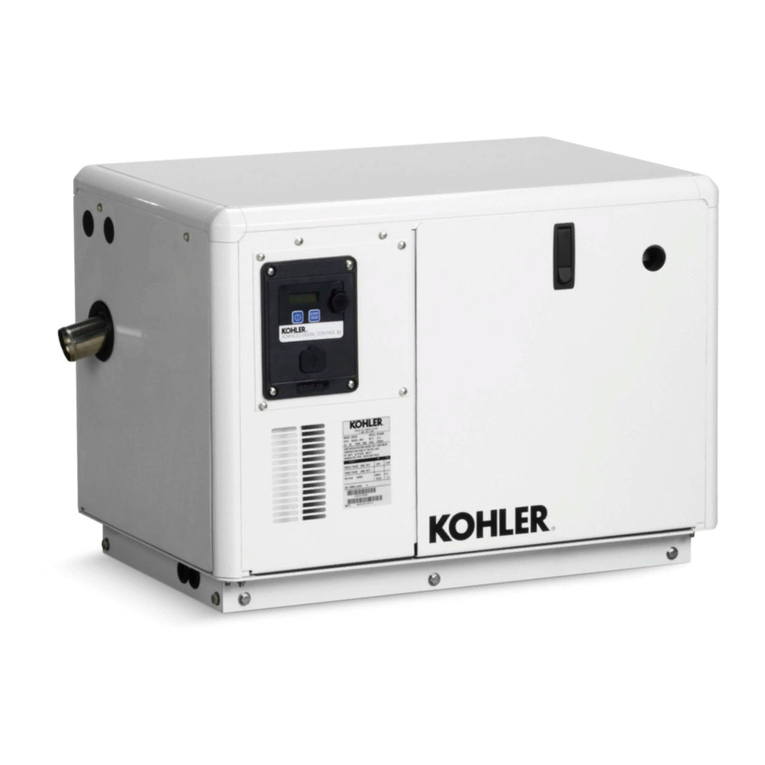
Kohler
Kohler 6EKOD User manual
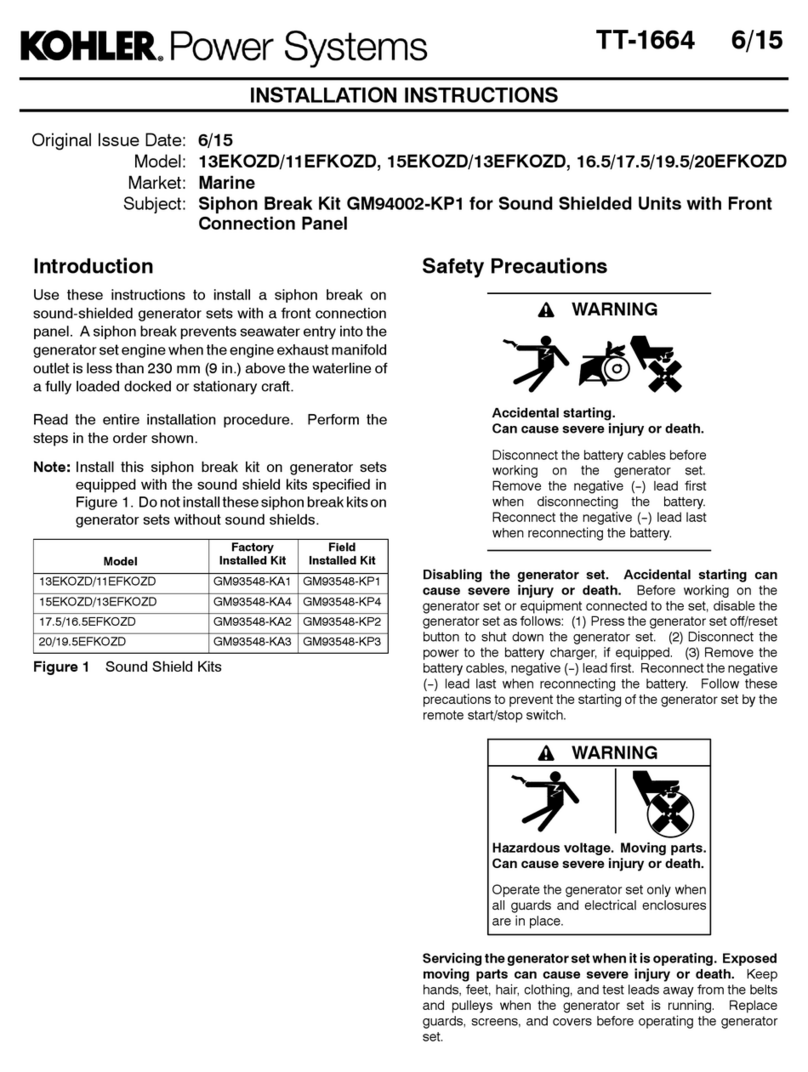
Kohler
Kohler 13EKOZD User manual

Kohler
Kohler GM89754-KP1 User manual
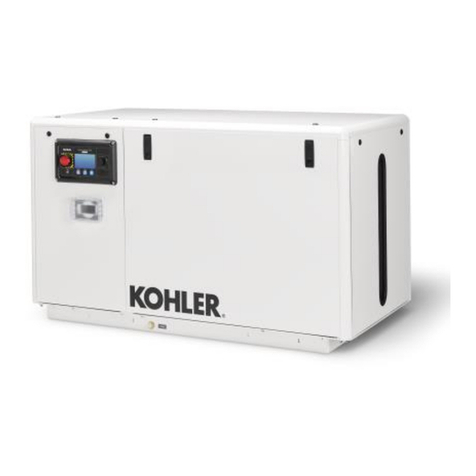
Kohler
Kohler 40EFOZDJ User manual
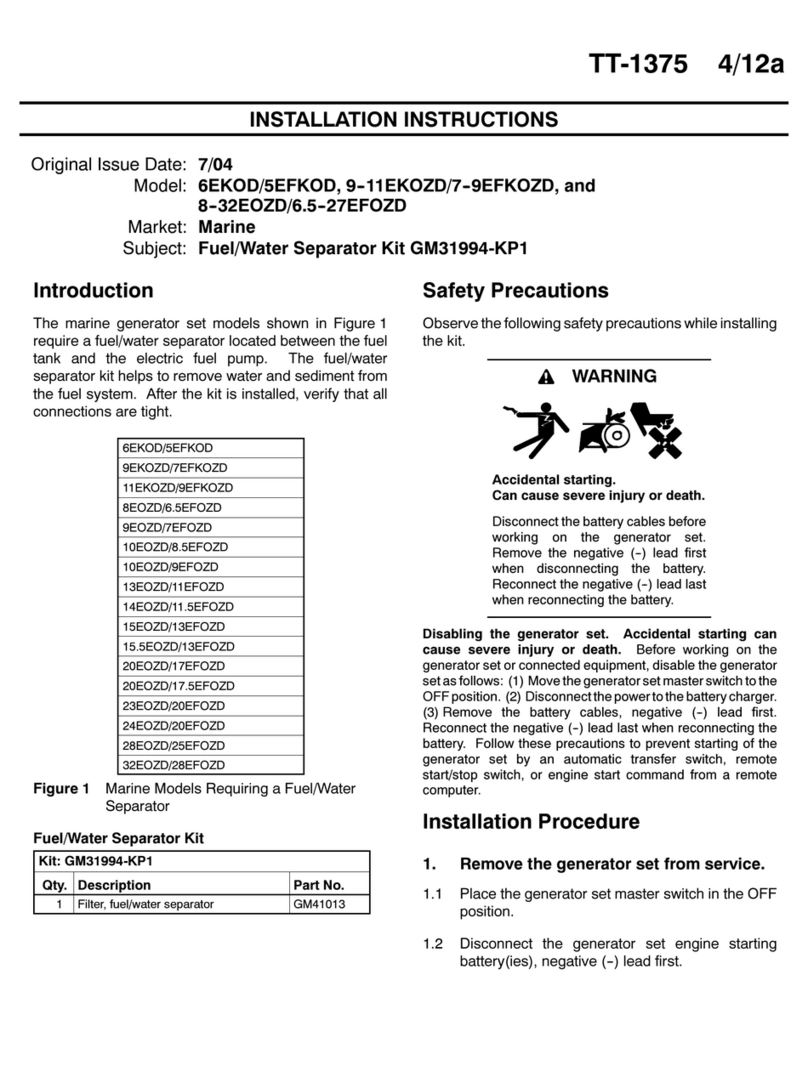
Kohler
Kohler GM31994-KP1 User manual
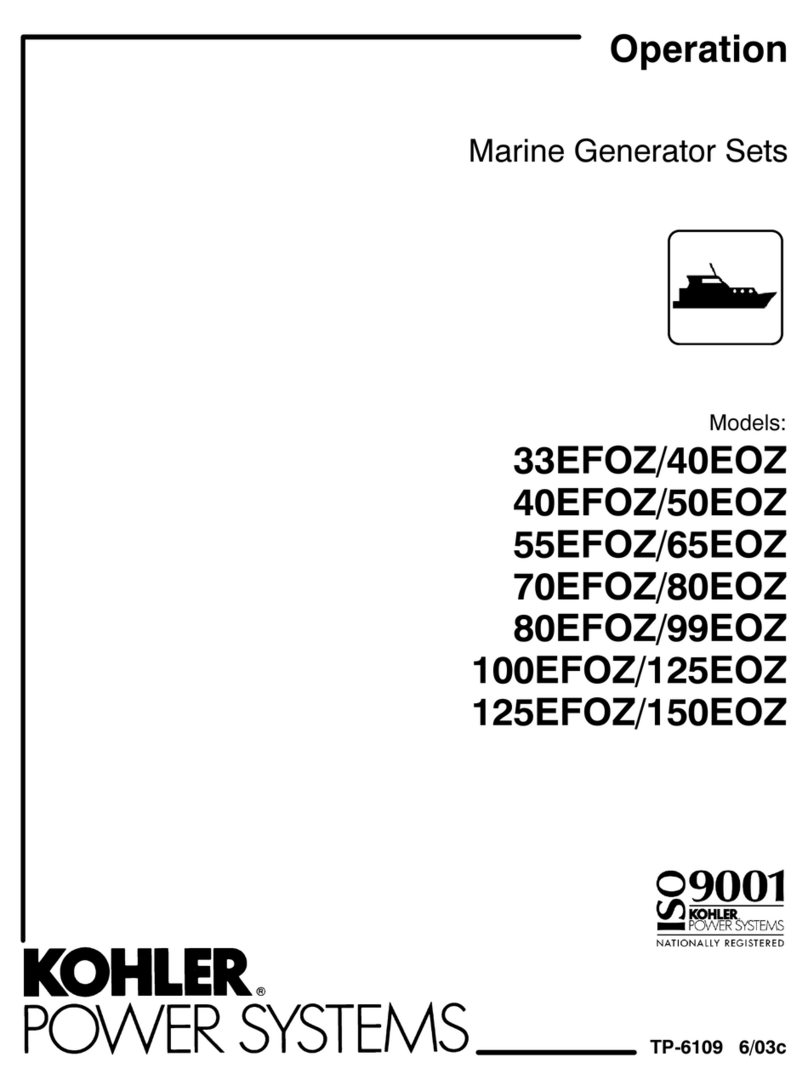
Kohler
Kohler 40EFOZ User manual

Kohler
Kohler 150EOZDJ User manual
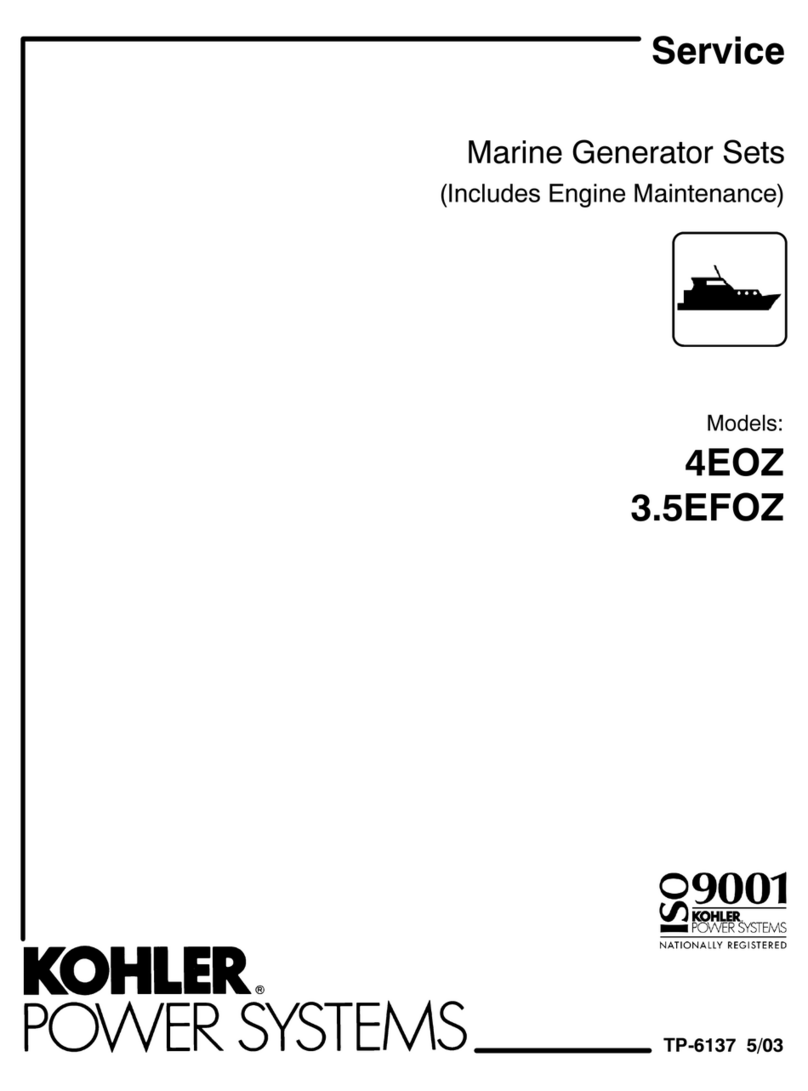
Kohler
Kohler 4EOZ Assembly instructions
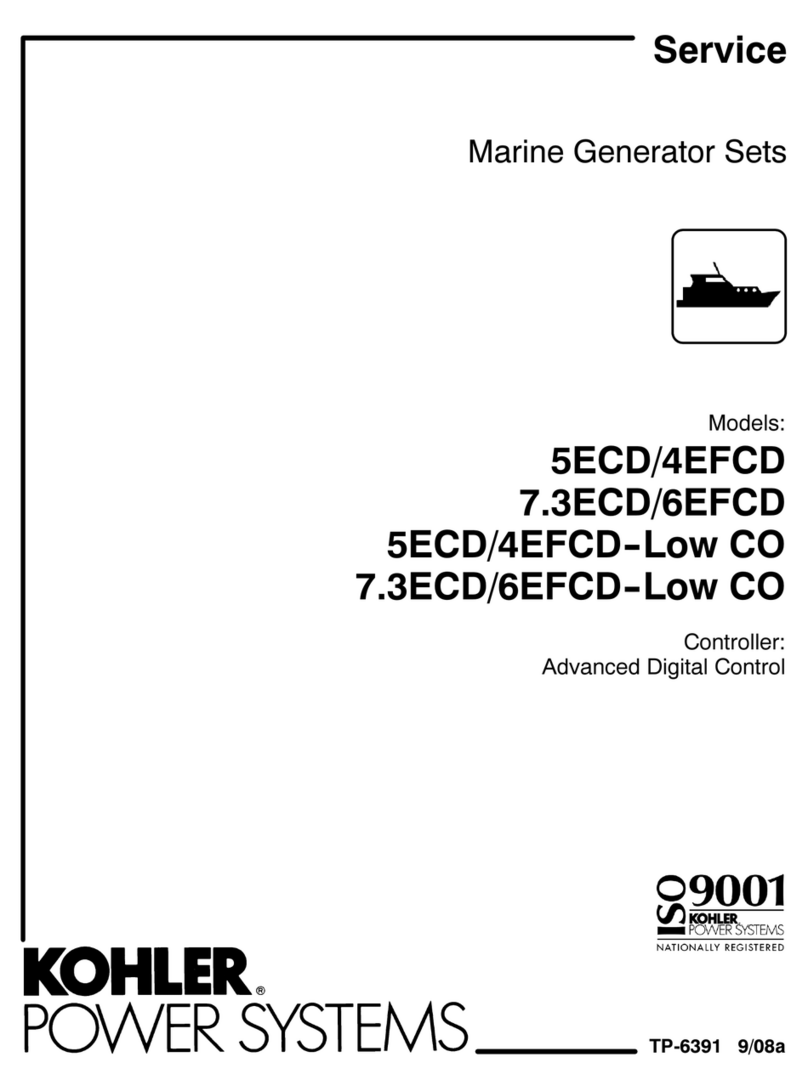
Kohler
Kohler 5ECD User manual

Kohler
Kohler 5EOZ User manual
